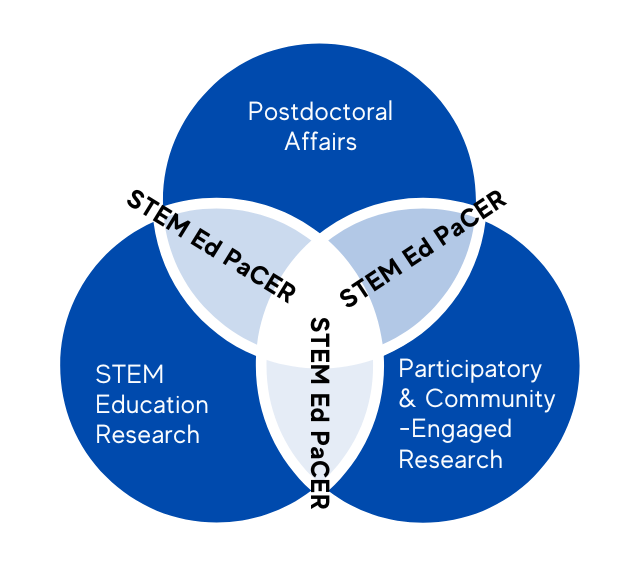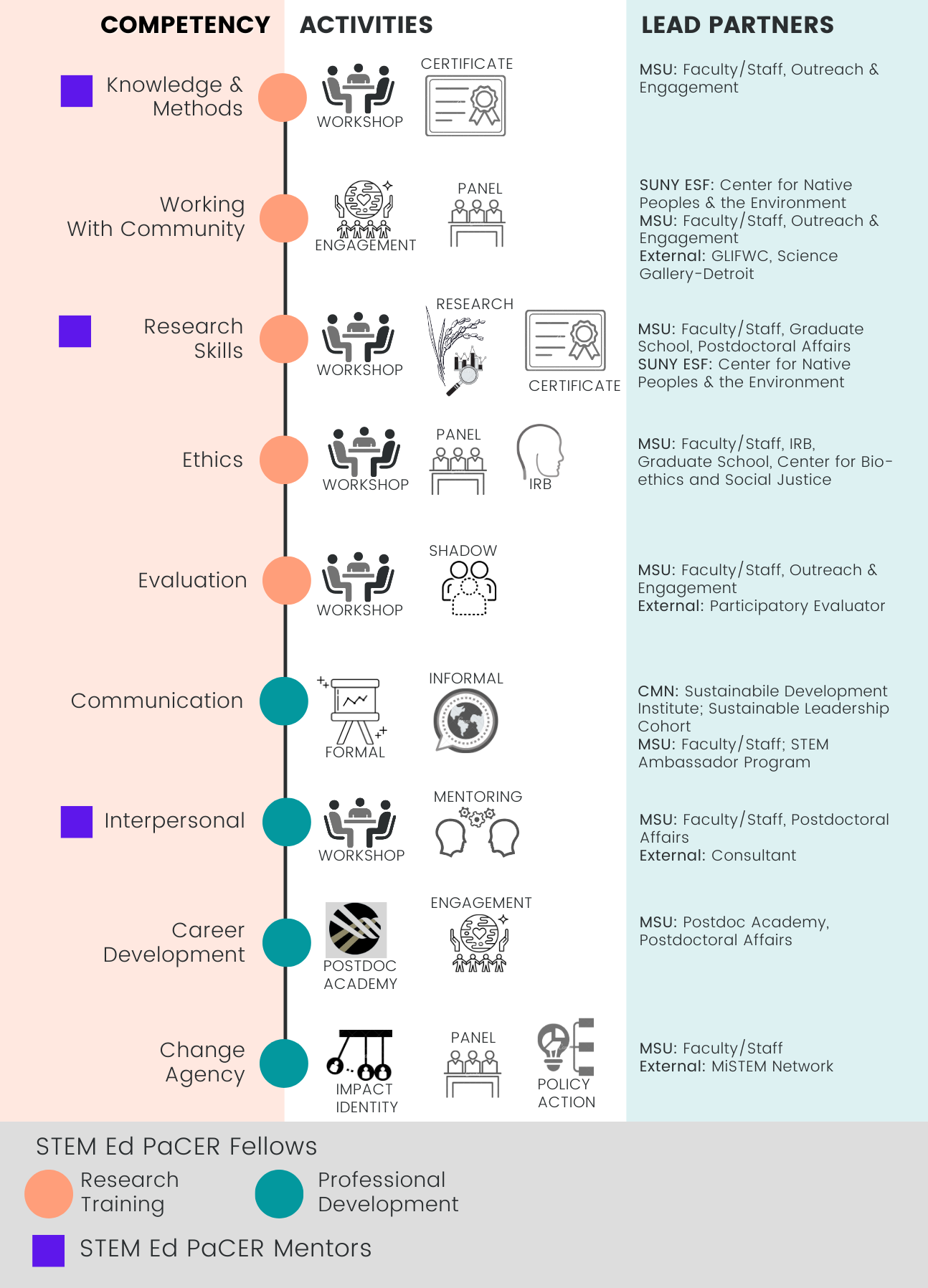 MSU researchers are reimagining fellowships to support the innovative and collaborative environment at MSU’s STEM Teaching and Learning Facility. Funded by organizations that include the National Science Foundation, the STEM Ed PaCER project designs and deploys a new model for fellowships to foster equity in research and in the selection of fellows. The STEM Ed PaCER fellowship program is for postdoc researchers interested in conducting Participatory and Community-Engaged Research with Indigenous communities. The program encourages fellows to use antiracist pedagogy and Indigenous ways of knowing.
MSU researchers are reimagining fellowships to support the innovative and collaborative environment at MSU’s STEM Teaching and Learning Facility. Funded by organizations that include the National Science Foundation, the STEM Ed PaCER project designs and deploys a new model for fellowships to foster equity in research and in the selection of fellows. The STEM Ed PaCER fellowship program is for postdoc researchers interested in conducting Participatory and Community-Engaged Research with Indigenous communities. The program encourages fellows to use antiracist pedagogy and Indigenous ways of knowing.
Foundational to the research in the STEM Ed PaCER program is the cultivation of researcher-community relationships grounded in reciprocity. The program will appoint fellows using equitable selection practices intended to expand the applicant pool and to encourage applicants doing innovative research regardless of where they secured a doctorate or currently work. Associate Dean for STEM Education Research & Innovation and Professor of Earth and Environmental Sciences, Julie Libarkin, and Director of Postdoctoral Affairs, Aaron Reifler, lead the new fellowship program which flips STEM Ed’s current fellowship model on its head to garner the best possible outcome from research efforts and to recruit postdocs that face barriers in thriving in traditional fellowships.
“The STEM Ed PaCER Postdoc Research Fellowship Program is an effort to move STEM education research away from a space where researchers are driving all the questions and making all of the decisions, moving it toward a community-engaged and participatory exercise where the research is cocreated,” said Associate Dean Libarkin, who serves as the grant’s principal investigator along with co- principal investigators Emiko Black (College of Human Medicine), NiCole Buchanan (College of Social Science), and Miles McNall (University Outreach and Engagement). “Research on teaching people STEM disciplines should include the voices of all the people that need to learn STEM subject areas. Participatory and community engaged research listens to the community to develop research questions and conducts research with the community, not on the community. It is a fundamental shift in how most research is conducted."
The art and science of teaching doesn’t evolve unless we engage the people who are learning. “We know that people learn in different ways and that learning methods need to be inclusive to be effective,” Associate Dean Libarkin explained.
“Participatory and community engaged research is a pedagogy that makes STEM Ed more accessible and inclusive to voices from the community that often get left out or left behind,” said Dr. Reifler.
Grant funding supports six STEM Education Postdoctoral Research Fellows who will train and work on Participatory and Community-Engaged Research in the context of STEM education. STEM Ed PaCER is a collaboration between MSU, the Center for Native Peoples and the Environment at the State University of New York’s Environmental Science and Forestry campus, and the Sustainable Development Institute of the College of Menominee Nation.
The STEM Ed PaCER team recognizes that STEM education is dominated by exploitative and colonial worldviews. They’d like to change that. “These worldviews can limit access and educational experiences for people of color, a population STEM must include to effectively advance the economic, social, and scientific well-being of all communities,” explained Dr. Reifler.
Indigenous communities are a focal point because of the contrast between their cultural worldview and the dominant western worldview. Participatory and community engaged research uses an asset-based approach to uncover new learning opportunities and strategies that grow out of the knowledge and wisdom of a community. The research becomes a community resource to share, not a commodity in limited supply.
STEM Ed PaCER is different from traditional fellowships in how mentorship is provided, and how research is conducted. “Faculty get postdocs, and the postdocs work on the faculty’s work. Sometimes postdocs get their own money and bring it to someone's lab, but they’re still working with that one person, often on that one person’s research. We're flipping that model on its head,” Associate Dean Libarkin explained. “Postdocs aren't getting a mentor – they're getting mentoring teams. The postdocs are not here in service of the mentors, the mentors are working in service of the postdocs. It's new. It's fun. It's interesting, exciting and a little daunting.”

The postdocs and the team of mentors will be oriented and trained in STEM recruitment, retention, or promotion of people of color in participatory and community engaged research in the STEM Ed PaCER model. To heighten the fellows’ understanding of collaboration and community engagement with Indigenous Peoples, “they'll be spending anywhere from a month to a semester at the College of Nominee Nation, creating curriculum and working in a tribal education context so they can get that deep experience,” shared Associate Dean Libarkin.
In the second year of the program fellows will undertake independent participatory and community-engaged STEM education research and participate in a Practicum in Indigenous STEM pedagogy in Chiapas, Mexico or work with Indigenous Peoples in Fiji for nine months.
STEM Ed PaCER embraces equity in its selection process for participating postdocs. The postdoc applicants are at the center of the process. The selection process for applicants is well underway with a remarkable 150 competitive applications for six positions. The grant to NSF outlines key practices to infuse equity into the selection process. So far, the process has gone to plan. Applicants reviewed mentor profiles containing values, work style, and an example project. They identified mentors they would be interested in working with.
Applications were de-identified prior to any review to avoid specific conscious and unconscious biases related to names, institutional background, or other privileges. De-identified applications were reviewed by at least three Leadership Team members. The program manager anonymized reviewer names, organized reviews, and calculated interrater reliability across reviewers.
“Community engagement and diversity in STEM education is lacking. We won’t get equity in the field until we truly involve people in the research design and as the researchers. PaCER is very exciting. The fellows will get paid through MSU for two years. NSF provided extra money to cover health insurance, equipment, travel, and research needs that fellows have if they need to fund their own research,” concluded Associate Dean Libarkin.
Putting resources in the hands of the Fellows and letting their research drive their fellowships is another way the STEM Ed PaCER program is flipping the script and bringing opportunities for scholarship and equity into a new model of postdoc work.